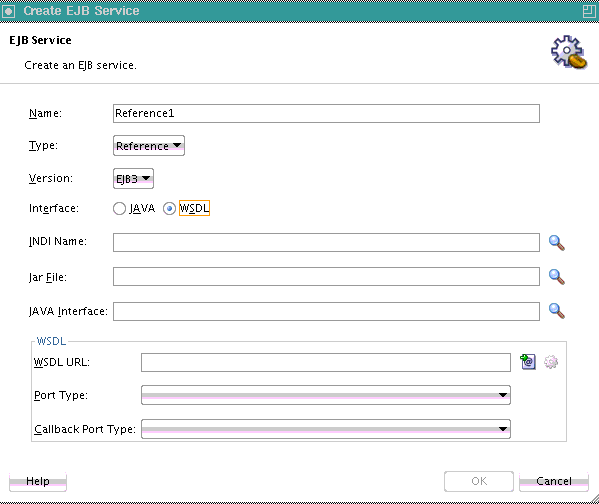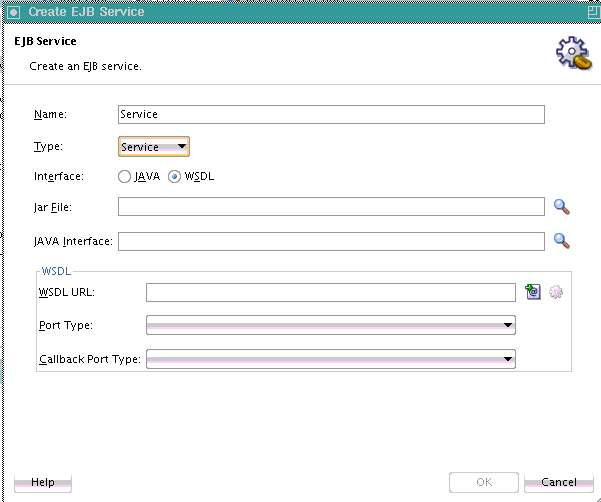How to Integrate SDO-based Enterprise JavaBeans with SOA Composite Applications
You can create the following types of SDO-based Enterprise JavaBeans integrations with SOA composite applications:
-
Invoke SDO-based Enterprise JavaBeans from a SOA composite application
-
Invoke a SOA composite application from Enterprise JavaBeans using SDO parameters
To integrate SDO-based Enterprise JavaBeans with SOA composite applications:
-
Go to the SOA composite application in the SOA Composite Editor.
-
In the Technology section of the Components window, drag the EJB icon into the appropriate swimlane, as described in Table 38-3.
Table 38-3 Swimlane for EJB Service
To Invoke... Drag the EJB Service to this Swimlane... SDO-based Enterprise JavaBeans from a SOA composite application
External References
A SOA composite application from Enterprise JavaBeans using SDO parameters
Exposed Services
The Create EJB Service dialog is displayed.
-
In the Interface section, click WSDL.
-
See the step in Table 38-4 based on the swimlane in which you dragged the EJB service.
Table 38-4 Swimlane Location
If You Dragged the EJB Service to this Swimlane... Then Go To... External References
Exposed Services
-
View the Create EJB Service dialog that displays in the External References swimlane, as shown in Figure 38-4.
Figure 38-4 Create EJB Service in External References Swimlane

Description of "Figure 38-4 Create EJB Service in External References Swimlane" -
View the Create EJB Service dialog that displays in the Exposed Services swimlane, as shown in Figure 38-5.
Figure 38-5 Create EJB Service in Exposed Services Swimlane

Description of "Figure 38-5 Create EJB Service in Exposed Services Swimlane"
-
-
Enter values appropriate to your environment. The fields that display differ based on the swimlane in which you dragged the EJB Service icon. Table 38-5 provides details.
Table 38-5 Create EJB Service Dialog
Field Value Name
Accept the default value or enter a different name.
Type
Displays the following value:
-
Displays Reference if you dragged this icon into the External References swimlane.
-
Displays Service if you dragged this icon into the Exposed Services swimlane.
Version
Note: This field only displays if you dragged the EJB Service icon into the External References swimlane.
Select the version of EJB to support: EJB2 or EJB3 (the default selection). If you select WSDL from the Interface list, only EJB3 is available for selection.
Interface
Select WSDL.
JNDI Name
Note: This field only displays if you dragged the EJB Service icon into the External References swimlane.
Enter the JNDI name of your Enterprise JavaBeans.
Jar File
Click the Search icon to select the EJB JAR file created in Designing an SDO-Based Enterprise JavaBeans Application. The JAR Chooser dialog searches for and displays JAR files starting in the SCA-INF/lib subdirectory of the current project directory. The JAR file includes the interface class and any supporting classes.
Note: If you select a JAR file outside of the current project, Oracle JDeveloper creates a copy of the JAR file in the SCA-INF/lib directory of the current project. When prompted, click OK to accept.
Java Interface
Click the Browse icon to invoke the Class Browser dialog for selecting the fully qualified Java class name of the previously created Enterprise JavaBeans interface. This class must exist in the selected JAR file. If a JAR file is not specified, it is assumed that the class is in the /SCA-INF/classes subdirectory of the current project directory.
Note: If you use the Jar File field, you do not need to add a new JAR file to the project by selecting Project Properties > Libraries and Classpath > Add JAR/Directory from the Application main menu.
WSDL URL
Note: Ensure that you have created the annotations for the Enterprise JavaBeans interface before generating the WSDL file, as described in How to Use Web Service Annotations.
Click the second icon to the right to generate a WSDL file that represents the Enterprise JavaBeans interface.
If you created SDO objects through Oracle JDeveloper, as described in How to Create SDO Objects Using the SDO Compiler, ensure that you select the WSDL file that was automatically generated with this option.
Port Type
Select the port type.
Callback Port Type
Select the callback port type (for asynchronous services).
-
-
Click OK.